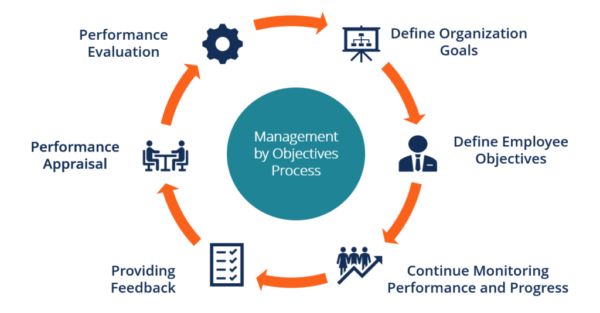Management by Objectives MBO Learn Its 5 Steps Pros and Cons

Management by Objectives (MBO): Learn Its 5 Steps, Pros and Cons
Management by objectives (MBO) is a strategic management model that aims to improve the performance of an organization by clearly defining objectives agreed to by both management and employees. Having a say in goal setting and action plans encourages participation and commitment among employees while aligning objectives across the organization.
Key Takeaways
– MBO is a process in which a manager and an employee agree on specific performance goals and develop a plan to reach them.
– It aligns objectives throughout an organization and boosts employee participation and commitment.
– The five steps are: define objectives, share them with employees, encourage employee participation, monitor progress, evaluate performance, and reward achievements.
– MBO critics argue that it leads to employees trying to achieve goals by any means necessary, often at the cost of the company.
Understanding Management by Objectives (MBO)
Management by objectives (also known as management by planning) is the establishment of a management information system (MIS) to compare actual performance and achievements with defined objectives. Practitioners claim that MBO improves employee motivation, commitment, and communication between management and employees.
However, a weakness of MBO is that it unduly emphasizes goal setting rather than working on a systematic plan. Critics argue that setting particular goals leads to shortcuts that result in poor quality.
MBO is not a cure-all but a tool to be utilized. It gives organizations a process, with practitioners claiming its success depends on top management support, clearly outlined objectives, and trained managers.
Management by Objectives (MBO) in 5 Steps
– Determine or revise organizational objectives derived from the firm’s mission and vision.
– Translate organizational objectives to employees using the SMART acronym: specific, measurable, acceptable, realistic, time-bound.
– Stimulate employee participation in setting individual objectives to achieve larger organizational objectives.
– Monitor employee progress by using measurable objectives.
– Evaluate and reward employee progress with honest feedback on achievements.
Advantages and Disadvantages of Management by Objectives (MBO)
Advantages:
– Tailored goals boost employee output and loyalty.
– Communication between management and employees is increased.
– Management can create goals for company success.
Disadvantages:
– MBO often focuses solely on goals and targets, ignoring other aspects of a company.
– Employees may face increased strain to meet goals.
– Meeting targets by any means necessary compromises work quality.
– MBO may not fit all management responsibilities.
Goal of Management by Objectives (MBO)
MBO uses quantifiable standards to measure company and employee performance. Comparing actual productivity to standards helps identify problem areas and improve efficiency.
Example of MBO
A call center can set goals to increase customer satisfaction by 10% and reduce call times by one minute. Employees work to achieve this goal, and progress is monitored, feedback provided, and good performance rewarded.
Drawbacks of Using MBO
MBO focuses solely on goals and targets, ignoring other aspects like corporate culture, worker conduct, and community involvement.
Difference Between MBO and Management by Exception (MBE)
MBE addresses instances where objectives or standards are transgressed, while MBO involves employees in goal setting and overall management objectives.
The Bottom Line
MBO theory encourages employee involvement in setting goals, but customization and clear objectives are crucial for successful implementation. Awareness of MBO drawbacks is necessary before commencing the process.



